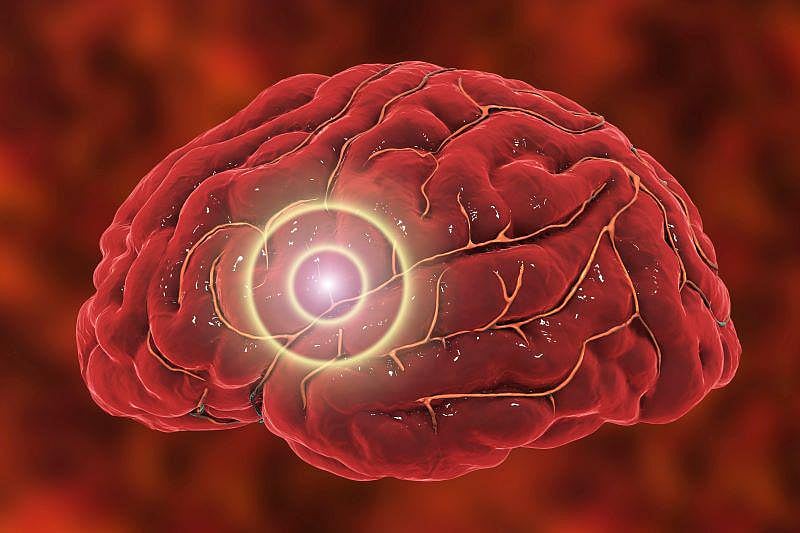Get Healthy!

- Posted February 23, 2023
Noninvasive Ultrasound Brain Treatment Might Help Slow Parkinson's
A noninvasive treatment that heats specific areas of brain tissue may ease movement symptoms in some people with Parkinson's disease, a clinical trial has found.
The study tested the effects of an incision-free procedure called focused ultrasound ablation, where doctors use sound waves to heat and destroy specific spots of brain tissue contributing to movement problems.
It has been used for several years to treat some patients with Parkinson's disease whose primary symptom is tremor in the limbs.
This latest trial aimed to treat a different group of patients: those troubled by dyskinesias -- a side effect of Parkinson's medications that causes the body to twitch or jerk involuntarily; and those who were still having movement problems between their medication doses.
Researchers found that of patients they randomly assigned to have focused ultrasound, 69% were showing a good response three months later. That compared with 32% of patients who underwent a "sham" version of the procedure.
The findings -- published Feb. 23 in the New England Journal of Medicine -- have already had an impact.
Based on the results, the U.S. Food and Drug Administration in late 2021 approved the device used in the trial, called Exablate Neuro, for treating movement problems in people with advanced Parkinson's.
But it's not yet covered by insurance, including Medicare, said researcher Dr. Howard Eisenberg, a professor and neurosurgeon at the University of Maryland Medical Center in Baltimore.
So for the time being, patients are paying out of pocket.
Parkinson's disease affects nearly 1 million people in the United States alone, according to the Parkinson's Foundation.
It involves an abnormal buildup of a protein called alpha-synuclein in the neurons (nerve cells) in the brain. Over time, the brain loses cells that produce dopamine, a chemical that helps regulate movement and emotional responses.
Parkinson's causes an array of symptoms, but the most visible signs are movement-related -- such as tremors, stiff limbs and coordination problems. Medications that either temporarily replenish dopamine, or mimic its actions, are a standard treatment for those movement symptoms.
Many people, though, develop dyskinesias as a side effect, or have movement problems crop up when their last medication dose starts to wane. At that point, they can opt to try a procedure -- and the "gold standard" is deep brain stimulation (DBS), Eisenberg said.
DBS involves implanting electrodes in specific areas of the brain to deliver electrical pulses that disrupt abnormal brain activity. It can ease Parkinson's symptoms, but the downside is that it requires open brain surgery and leaving hardware in the body (including a pacemaker-like device in the chest).
"Some people don't like the idea of having a device implanted," Eisenberg said. "It's scary to them."
Focused ultrasound offers a noninvasive alternative. Doctors use MRI imaging to visualize the brain and guide ultrasound beams to tiny areas of tissue to heat and disable. Eisenberg likened it to using a magnifying glass to focus a ray of sunlight on a leaf to burn a pin-size hole.
The current trial, funded by Exablate Neuro's manufacturer Insightec, involved 94 patients with dyskinesias or movement impairments despite medication. The researchers randomly assigned 69 to undergo the ultrasound procedure, while 25 had a sham (inactive) version of it.
Three months later, 69% of patients who had the real treatment were considered responders -- based on a pre-defined improvement in their scores on a standard measure of Parkinson's movement problems.
That means, however, that almost one-third did not have such a response, said Anette Schrag, a neurologist at University College London.
And right now, it's hard to predict which patients are likely to respond well, said Schrag, who wrote an editorial published with the study.
James Beck is chief scientific officer at the nonprofit Parkinson's Foundation.
He said focused ultrasound "represents an important tool for those few patients who may not otherwise qualify for DBS or may not want to undergo the procedure."
But, Beck said, DBS has advantages over ultrasound: "Unlike DBS, focused ultrasound cannot treat progressively worsening symptoms, and the lesion cannot be modified after treatment."
In contrast, he said, DBS can be "continuously adjusted" and the implants can be removed if needed.
And while ultrasound is incision-free, that does not mean it's risk-free, Eisenberg said. It can cause side effects like loss of taste, visual disturbances and slurred speech.
In the trial, those side effects were mostly mild and resolved within a few weeks. But, Eisenberg said, they do not always go away.
Another big question is the "durability" of the benefits, Eisenberg said. The trial patients will be followed for five years to get an answer.
For now, focused ultrasound can only be performed on one side of the brain when it's done for Parkinson's movement problems -- meaning it can only ease symptoms on the opposite side of the body. So doctors treat the more severely affected side.
Eisenberg and his colleagues are now conducting a trial of using the procedure on the both sides of the brain.
More information
The Parkinson's Foundation has more on Parkinson's disease treatment.
SOURCES: Howard Eisenberg, MD, professor, neurosurgery, University of Maryland School of Medicine, neurosurgeon, University of Maryland Medical Center, Baltimore; James Beck, PhD, chief scientific officer, Parkinson's Foundation, Miami/New York City; Anette Schrag, PhD, professor, clinical neuroscience, consultant neurologist, University College London; New England Journal of Medicine, Feb. 23, 2023
